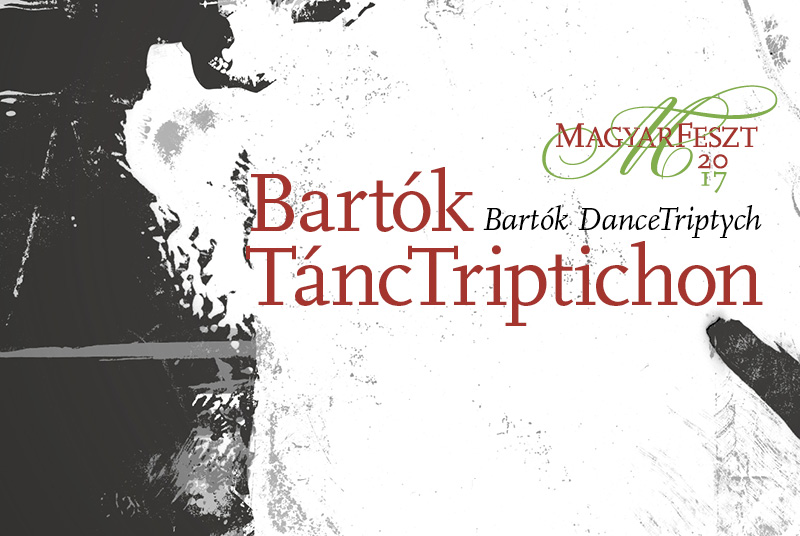
Bartók DanceTriptych
28 May 2017, 7 p.m.
In Brief
Three one-act dance pieces
The first work featured in our Bartók DanceTriptych programme is Pál Frenák's new staging of The Wooden Prince, which the world-famous choreographer created for the work's centenary, with the contemporary dancers of Compagnie Pal Frenak and the artists of the Hungarian National Ballet both participating. Following this will be László Seregi's choreography of The Miraculous Mandarin and Zsolt Juhász's Dance Suite. Bartók's latter work, originally inspired by folk music and integrating folk dance and ballet techniques, will be performed jointly by the artists of the Duna Art Ensemble and the Hungarian National Ballet. The title Bartók DanceTriptych thus refers to more than just the number of works being presented: it also conveys the fact that three different styles of dance will be on display. This show promises to be a remarkable experience for anyone with an interest in dance.
Details
- Location
- Hungarian State Opera
- Date
- May 28, 2017
- Start time
- 7 p.m.
- End time
- 9:30 p.m.
Synopsis
The Wooden Prince
Standing on two adjacent hillocks are a pair of pretty castles belonging to the prince and princess: these are surrounded by a lush natural setting ruled over by the fairy. The prince goes out wandering, and in doing so discovers his beautiful neighbour. He falls in love at first sight, and unsuccessfully attempts to get her to notice him. He tries to get closer to his quarry, but as soon as he heads toward the neighbouring castle, the forest moves at the fairy's command, and trees block his path. The prince finds his way through the thicket, but the fairy causes the waters to rise and the waves to hold him back. As the prince does battle with the elements, the object of his affection remains indifferent, simply staring at herself in her mirror.
The prince, in order to attract the attention of his chosen one and teach her a lesson at the same time, sets about carving a replica of himself out of wood: out of a rough log, he fashions a human shape, fastens his own crown on its head and drapes his robe on its shoulders. The magical power of the fairy brings the doll to life, and it immediately launches into a grotesque dance, which succeeds in coaxing the princess to come outside: enchanted, she joins the strange figure to dance a magnificent duet with it, and then takes it back into her castle with her. As the prince sadly watches his creation's triumph, the fairy now comforts him and orders the forces of nature to submit to the prince and aid him. Meanwhile, the power of the wooden doll is waning: gazing at the figure as it lurches with grotesque movements, she realises how mistaken she had been to not choose its creator, her own flesh-and-blood admirer. She sets out to look for the prince, only to have the fairy create the same obstacles for her that the prince encountered. The love-smitten princess withstands the trials: the loving couple, after fighting courageously for each other, finally find each other. During their happy duet in the closing scene, their love is fulfilled surrounded by a natural world which is now silent and protective.
The Miraculous Mandarin
In an out-of-the-way corner of a barren gang-ridden neighbourhood in the jungle of a big city, three tramps are passing the time. Palpable in their movements are both boredom and the anxiety of waiting that is only enhanced by the disturbing sounds and lights of the metropolis. The girl arrives: together, the tramps are keeping her captive and pimping her: from the window of the dilapidated hideaway, she attempts to lure in customers, who will then become the gang's victims. The first to arrive is a dandy, a gentleman still showing his vigour: the old gallant. While he makes passionate advances at the girl, the three tramps dash out, rob him and toss him out in the street. The next patron is the student: a shy and excited young man who is mesmerised by the beauty of this girl who lives from selling her body. The tramps set on the lad as well, but there's nothing to take from him: they beat him up and throw him out. Then they scold the girl for not managing to entice in wealthier dupes and push her out onto the balcony again. Just then, mysterious and mystical music suggesting the approach of some superhuman power is heard – the girl runs into the room, where the Mandarin appears like an otherworldly apparition.
The proximity of the mystical stranger, doll-like in his lack of motion, nearly paralyses the girl, who at first finds all of her skill and experience to be of no use with him. Then, her increasingly provocative and goading dance suddenly has its effect: the Mandarin unfreezes, and with tremendous passion throws himself on the escaping girl. Now the tramps' primary concern is saving her life: they hardly have the strength to hold back the practically invulnerable, frenzied stranger. In the savage, swirling fight that ensues, the three bandits overcome the Mandarin, whom they first stab, then start to strangle, before finally throwing a noose around his neck. The girl starts to feel pity and takes the dying stranger in her arms. With her gentle motions, she redeems him in his death, becoming one with and understanding the stranger, as well as finding familiarity in him.
Tamás Halász